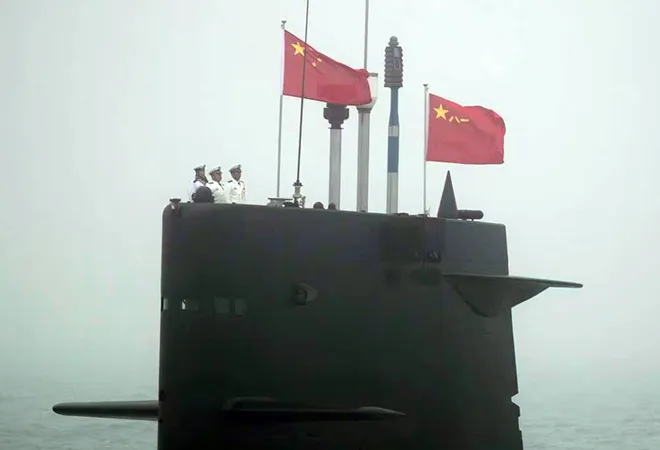-
CENTRES
Progammes & Centres
Location
With the launch of its Global Development Initiative in 2021, China is looking to recalibrate and redefine its outlook towards development cooperation

This is the 146th in the series–The China Chronicles.
The current economic crisis triggered by the COVID-19 pandemic, followed by the ongoing Russia-Ukraine conflict has had a mixed impact on the development finance architecture. Although the global GDP fell drastically, the volumes of Official Development Assistance (ODA) from traditional donors reached its peak of almost US$ 161 billion in 2020. Currently, the ODA offered by the Development Assistance Committee (DAC) members is about US$ 204 billion in 2022, illustrating an increase of 13.6 percent in real terms compared to 2021. This certainly underlines the fundamental trait of ODA- being a shock-absorbent in times of exigencies. In spite of the economic slowdown and increasing uncertainties, ODA touched its highest growth rates along with a ‘slowing-but-positive-GDP growth’ in the OECD countries
(Figure 1).
Figure 1: ODA increases vis-à-vis slowing GDP
Source: OECD-DAC Report, 2021
On the other, it has also come to the fore that recurrent use of ODA as an emergency response measure could actually mean reduction of funds for long-term developmental needs. Furthermore, the higher levels of debt, especially for the Least Developed Countries (LDCs) and low-income economies are raising serious concerns. Although lending through ODA channels does not necessarily compose of debts, it automatically indicates an increasing demand for concessional resources. Here, China is the largest bilateral lender to developing countries. As per the World Bank, Beijing has extended about USD 138 million as new loans between 2010 and 2021; some estimates place the total lending at almost USD 850 billion (Figure 2).
Figure 2: How the Debt is Distributed as per Creditors
Source: World Bank data compiled by the Boston University Global Development Policy Center- By Kripa Jayaram and Libby George, Reuters.
Undoubtedly, in its 60-year long history, ODA or more popularly known as development partnerships, has emerged as the most stable and decisive tool of external finance for the developing economies. Even so, ODA is not devoid of geopolitics. In fact, the great power competition is visibly penetrating the international development landscape, putting developing economies under pressure to navigate the shifting geopolitical currents. In this context, the gradual rise of China has not only intensified the geopolitical competition but also given ‘development partnership’ an alternative connotation—one that is value-based, ideological, and securitised in nature.
As one of the leading development partners from the Global South, China’s repertoire of projects initially pertained to hard-core physical infrastructure and economic connectivity under the Belt and Road Initiative (BRI). However, in the face of the pandemic, several of its initiatives were put on ‘temporary hold’ or ‘halted’ resulting in delays, monetary losses and in some cases, even renegotiations. In fact, Beijing even went ahead to unveil a minor debt relief package to 17 least-developed African countries, in the aftermath of the pandemic. With the launch of its Global Development Initiative (GDI) in 2021, China is looking to recalibrate and redefine its outlook towards development cooperation. As a fact, GDI comes as a strategic move; a tool that Beijing intends to utilize for gaining recognition in the area of global governance. While facing severe criticism at the international stage for unfolding the trap of ‘debt diplomacy’ through BRI followed by the spread of Covid-19, China is raring to refurbish its external branding. In fact, GDI streamlines BRI. Undoubtedly, development cooperation is one such critical instrument playing a pivotal role in leveraging the potential of global public good, especially in the backdrop of a raging war in Europe and an ongoing pandemic. Laying down the GDI as a pathway for accelerating the sustainable development process, China’s vision of development cooperation is gradually undergoing a change. One of the big brush takeaways of GDI possibly happens to be China’s inclination to step into softer sectors, such as humanitarian development cooperation, boosting economic growth in low-income countries and ultimately aligning its projects with Agenda 2030. For instance, the 2021 White Paper on Development Cooperation underscores the importance of poverty reduction, improving agro-productivity to create resilient food supply chains, improving public health systems, raising rural incomes etc.
Laying down the GDI as a pathway for accelerating the sustainable development process, China’s vision of development cooperation is gradually undergoing a change.
Although the very release of this white paper immediately after COVID-19 casts a shadow on Beijing’s intentions, it reflects its growing interest in making a statement as a global humanitarian development actor. As it appears, venturing into the humanitarian aid space turns out to be quite appealing to the Chinese leadership from a geostrategic perspective. Experts believe that GDI complements BRI; in fact, GDI should be examined alongside the Global Security Initiative (GSI). Interpreted as a ‘geostrategic offering’ by Beijing for addressing common, comprehensive, cooperative and sustainable security challenges. Countering the US-led global order, through GDI and GSI, China is pointing towards revamping the political and social state of affairs. However, experts observe that although GDI talks of furthering the sustainability agenda through multilateral channels and institutions, it shows signs of an atypical Chinese way of doing things, such as the ‘development-first principle’ and ‘action-oriented approach’.
Talking of the Indo-Pacific, China is the largest trading partner to almost 120 countries in the region. Its growing footprint in this geographical space can be attributed to two reasons- the shifting balance of power with the relative decline of USA and the mounting developmental challenges giving leverage to China’s geopolitical and geoeconomic aspirations. In fact, China has been aiming to ramp up its engagement with several multilateral organizations, including the UN to align its development partnership model with Agenda 2030. Here, the Indo-Pacific forms an essential component of the sustainability map. The region faces severe challenges in the form of lack of access to digital connectivity, democracy deficit, climate induced disasters, low levels of economic development etc. Moreover, their remoteness and lack of geographical proximity to the mainland only complicates these challenges. As recipients of development aid, these small island nations cannot afford to ignore the great power competition. For instance, the letter released in March this year by the outgoing President of Federated States of Micronesia (FSM), David Panuelo spotlighting the ‘political warfare’ induced by Beijing over Taiwan in the Pacific Islands. Aiming to gather allegiance of the small island nations, China’s outlook towards the Indo-Pacific is strategically inclined. At the same time, it is difficult for the international community to de-couple from China—for example, the European Union (EU) describes Beijing as filling the threefold role of partner, competitor, and rival.
China has been aiming to ramp up its engagement with several multilateral organizations, including the UN to align its development partnership model with Agenda 2030.
On the contrary, the historic first visit by an Indian Prime Minister to Papua New Guinea (PNG) earlier this year comes at a crucial juncture. This visit by PM Modi is important as it came in the midst of the geopolitical contest due to China’s growing presence in the region rich in resources. By jointly hosting the Third Summit of the Forum for India-Pacific Islands Cooperation (FIPIC) with PNG, India’s foreign policy objectives are now reconfiguring to include the Pacific Island Countries (PICs). Offering a vociferous representation to the Global South, India unveiled the 12-step action plan to solidify its development partnership with the PICs and also consolidate the shared vision of a free, open and prosperous Indo-Pacific. As a G20 President, India is also pushing for development as a core issue for the Global South. For example, India’s proposal to invite the African Union (AU) as a full member of the G20. This is certainly a positive step, not only for the African continent but also for the PICs as development of the vulnerable communities is being prioritised. With three months left for the G20 Summit in September, it would be interesting to see how New Delhi shapes the development narrative strategically to address the SDG financing gap in the Indo-Pacific.
Swati Prabhu is Associate Fellow with the Centre for New Economic Diplomacy (CNED) at the Observer Research Foundation
The views expressed above belong to the author(s). ORF research and analyses now available on Telegram! Click here to access our curated content — blogs, longforms and interviews.

Dr Swati Prabhu is Associate Fellow with the Centre for New Economic Diplomacy at the Observer Research Foundation. Her research explores the interlinkages between development ...
Read More +